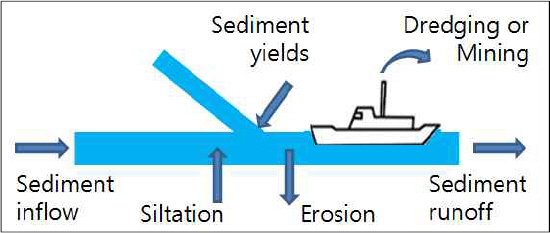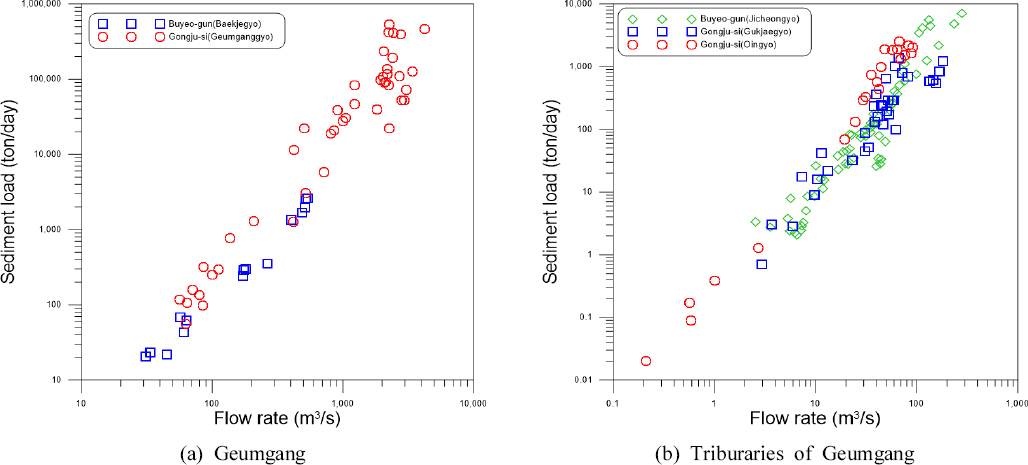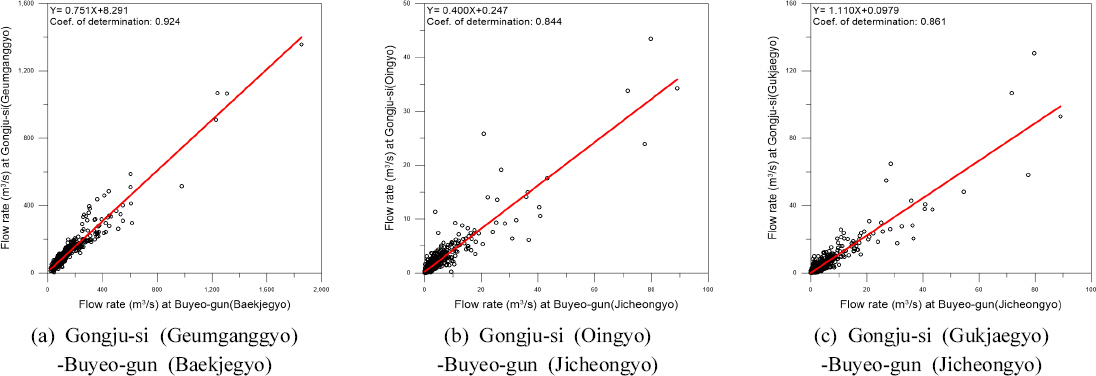 |
 |
- Search
| J. Korean Soc. Hazard Mitig. > Volume 21(6); 2021 > Article |
|
Abstract
Sediment measurement data are utilized as basic data for various river plans and research. The aim of this study is to compare between sediment budget analysis and riverbed monitoring results. The spatial range was from the Gongju-si (Gemganggyo) station to the Buyeo-gun (Baekjegyo) station in Geumgang, and the temporal range in this study was from 2011 to 2016. The estimated change in riverbed amount using the sediment budget analysis was 2,430,243 tons for sediments loaded over six years in the section. The analyzed riverbed changes sedimentation using the riverbed monitoring method were 2,165,146 tons based on the low level and 3,055,489 tons based on the flood level. Based on the riverbed monitoring performance, the relative errors in the sediment budget analysis results through sediment measurements were 10.9% and -25.7% for the low water and flood levels, respectively.
ВџћВДђ
ьЋўВ▓юВЮў ВюаВѓгвЪЅ ВИАВаЋВъљвБївіћ вІцВќЉьЋю ьЋўВ▓ю Ж│ёьџЇЖ│╝ ВЌ░ЖхгВЌљ ЖИ░В┤ѕВъљвБївАю ьЎюВџЕвљювІц. ВЮ┤ ВЌ░ЖхгВЌљВёювіћ вІцвЁёЖ░ёВЮў ьЋўВ▓ю вІевЕ┤ ВИАвЪЅ Ж▓░Ж│╝ВЎђ ВюаВѓгвЪЅ ВИАВаЋВъљвБї ЖИ░в░ўВЮў ВюаВѓг ВѕўВДђ вХёВёЮ Ж▓░Ж│╝вАю Вѓ░ВаЋвљю ьЋўВЃЂ в│ђвЈЎвЪЅВЮё в╣ёЖхљРІЁЖ▓ђьєаьЋўВўђвІц. ВюаВѓг ВѕўВДђ вХёВёЮВЮў Ж│хЖ░ёВаЂ в▓ћВюёвіћ ВЃЂРІЁьЋўвЦў Ж▓йЖ│ё в░Ј ВДђвЦў ьЋўВ▓юВЌљВёю ВюавЪЅ в░Ј ВюаВѓгвЪЅВЮ┤ вфевЉљ ВИАВаЋвљю ЖИѕЖ░ЋВЮў Ж│хВБ╝ВІю(ЖИѕЖ░ЋЖхљ) ВѕўВюёЖ┤ђВИАВєївХђьё░ вХђВЌгЖх░(в░▒ВаюЖхљ) ВѕўВюёЖ┤ђВИАВєї ЖхгЖ░ёВЮ┤Ж│а, ВІюЖ░ёВаЂ в▓ћВюёвіћ 2011вЁёвХђьё░ 2016вЁёЖ╣їВДђВЮ┤вІц. вХёВёЮ Ж▓░Ж│╝, вХёВёЮ вїђВЃЂ ЖхгЖ░ёВЌљВёювіћ 6вЁёЖ░ё 2,430,243 tonВЮў ВюаВѓгЖ░ђ ьЄ┤ВаЂвљўвіћ Ж▓ЃВю╝вАю вХёВёЮвљўВЌѕвІц. ьЋюьјИ, вїђВЃЂ ЖхгЖ░ёВЌљ вїђьЋўВЌг ВИАвЪЅвљю ьЋўВ▓ю ВДђьўЋВЮё ВЮ┤ВџЕьЋўВЌг ьЋўВЃЂ в│ђвЈЎвЪЅВЮё Вѓ░ВаЋьЋўВўђвІц. ЖиИ Ж▓░Ж│╝, ВађВѕўВюё ЖИ░ВцђВЮў ьЄ┤ВаЂвЪЅВЮђ 2,165,146 ton, ьЎЇВѕўВюё ЖИ░ВцђВЮў ьЄ┤ВаЂвЪЅВЮђ 3,055,489 tonВю╝вАю вХёВёЮвљўВЌѕвІц. ьЋўВ▓ю ВИАвЪЅ Вё▒Ж│╝вЦ╝ ЖИ░ВцђВю╝вАю в│╝ вЋї, ВА░Вѓгвљю ьЋўВЃЂ в│ђвЈЎвЪЅЖ│╝ ВюаВѓг ВѕўВДђ вХёВёЮ Ж▓░Ж│╝вАю Вѓ░ВаЋвљю ьЋўВЃЂ в│ђвЈЎвЪЅВЮў В░еВЮ┤віћ ВађВѕўВюёВЎђ ьЎЇВѕўВюё ЖИ░ВцђВЌљВёю Ж░ЂЖ░Ђ 10.9%ВЎђ -25.7%вАю вХёВёЮвљўВЌѕвІц.
ьЋўВ▓юВЮў ВюаВѓгвЪЅВЮђ ВюаВѓгВЮў ВЮ┤вЈЎвЦаВЮё ВЮўв»ИьЋўЖ│а, вІеВюё ВІюЖ░ёвІ╣ вг┤Ж▓ї вўљвіћ вІеВюё ВІюЖ░ёвІ╣ вХђьћ╝вАю вѓўьЃђвѓИвІц. ьЋўВ▓юВЌљВёю ВюаВѓг ВЮ┤ВєАВЮђ ВєївЦўВѓгВЎђ вХђВюаВѓг ьўЋьЃювАю в░юВЃЮьЋўвЕ░, ВЮ┤вЦ╝ ьЋЕьЋю Ж▓ЃВЮ┤ В┤Ю ВюаВѓгвЪЅВЮ┤ вљювІц. ВєївЦўВѓгвіћ ьЋўВ▓ю в░ћвІЦВЌљВёю ВА░вдйьєаЖ░ђ ЖхгвЦ┤Ж│а в»И‿┤ВДђвЕ░ вЈёВЋйьЋўвЕ┤Вёю ьЋўвЦўвАю ВЮ┤вЈЎьЋўвЕ░, вХђВюаВѓгвіћ ьЮљвдёВЌљ ВЮўьЋю вѓювЦў Вџ┤вЈЎВЌљвёѕВДђВЌљ ВЮўьЋ┤ ВюаВѕў ВцЉВЌљ вХђВюа ВЃЂьЃювАю ьЋўвЦўвАю ВЮ┤вЈЎьЋювІц(Choi et al., 2017).
ьЋўВ▓юВЮў ВюаВѓгвЪЅ ВХћВаЋВЮђ ьЋўВ▓ю вѓ┤ВЮў ВѕўвдгЖхгВА░вг╝ВЮў ВёцЖ│ё в░Ј ВюаВДђЖ┤ђвдг, ьЋўВ▓ю Ж░юВѕў в░Ј ьЋўвЈёВЮў ВЋѕВаЋ, ьЎЇВѕўьё░ Ж┤ђвдг, ВађВѕўВДђВЮў ВёцЖ│ё в░Ј Вџ┤ВўЂ вЊ▒ ьЋўВ▓ю Ж│ёьџЇВЌљ ьЋёВџћьЋю ЖИ░в│ИВаЂ ВџћВєї ВцЉ ьЋўвѓўВЮ┤вІц(Han et al., 2011). Вџ░вдгвѓўвЮ╝ВЌљВёювіћ 1960~1970вЁёвїђвХђьё░ ВаёЖхГ ВюаВЌГВА░Вѓг ВѓгВЌЁЖ│╝ IHP ВѓгВЌЁВЌљВёю ВюаВѓгвЪЅ ВА░ВѓгЖ░ђ В▓ўВЮї ВІюВъЉвљю ВЮ┤ьЏё, 2000вЁёвїђВЌљвіћ ВаёЖхГ ВюаВЌГВА░Вѓг ВѓгВЌЁВЮў ВъгВІцВІюВЎђ ВѕўвгИВА░Вѓг ВѓгВЌЁВЮ┤ ВДёьќЅвљўвЕ┤Вёю ВюаВѓгвЪЅ ВА░ВѓгЖ░ђ в│ИЖ▓ЕВаЂВю╝вАю ВѕўьќЅвљўВЌѕвІц(Kim and Kwon, 2018). ьЋюЖхГВѕўВъљВЏљВА░ВѓгЖИ░ВѕаВЏљВЌљВёювіћ вДцвЁё ВаёЖхГВЮў ВБ╝Вџћ ВДђВаљВЌљВёю ВюаВѓгвЪЅ ВИАВаЋВЮё ВѕўьќЅьЋўЖ│а ВъѕвіћвЇ░, 2021вЁё ьўёВъг 4вїђЖ░Ћ ЖХїВЌГВЮў ВюаВѓгвЪЅ ВИАВаЋ ВДђВаљВЮђ 24Ж░юВєїВЮ┤вІц(ME, 2021).
ьЋюьјИ, ьЋюЖхГВѕўВъљВЏљВА░ВѓгЖИ░ВѕаВЏљВЌљВёювіћ ьЋўВ▓юВюавЪЅВЮ┤ Ж┤ђВИАвљўвіћ ВДђВаљВЌљВёю вХђВюаВѓг вєЇвЈёвЦ╝ ВИАВаЋьЋўВЌг ьЋўВ▓юВЮў вХђВюаВѓгвЪЅВЮё ВИАВаЋьЋювІц. ЖиИвдгЖ│а вХђВюаВѓгВЮў ВъЁЖ▓й вХёьЈг, ьЋўВЃЂьєаВЮў ВъЁвЈё вХёьЈг, Ж┤ђвае Вѕўвдг ВЮИВъљ вЊ▒ВЮё ВѕўВаЋ ВЋёВЮИВЅгьЃђВЮИ в░Ев▓Ћ(modified Einstein procedure)ВЌљ ВаЂВџЕьЋўВЌг ВєївЦўВѓгвЪЅВЮё ВХћВаЋьЋўВЌг В┤Ю ВюаВѓгвЪЅВЮё Вѓ░ВаЋьЋювІц(ME, 2020). вћ░вЮ╝Вёю ВА░Вѓгвљю В┤Ю ВюаВѓгвЪЅВЮђ ВДЂВаЉ ВИАВаЋВ╣ўЖ░ђ ВЋёвІї ВХћВаЋВ╣ўвАюВёю ВИАВаЋ ВўцВ░е(error of measurement) ВЮ┤ВЎИВЌљвЈё ВХћВаЋ ВўцВ░евЦ╝ ьЈгьЋеьЋа Вѕў ВъѕвІц. ВЮ┤ВЎђ Ж┤ђваеьЋўВЌг ьЎўЖ▓йвХђВЌљВёювіћ ВѕўВъљВЏљВЮў ВА░ВѓгРІЁЖ│ёьџЇ в░Ј Ж┤ђвдгВЌљ Ж┤ђьЋю в▓ЋвЦаЖ│╝ ьЎўЖ▓йвХђ Ж│аВІю Ваю2018-94ьўИ РђўВѕўвгИВА░ВѓгВІюВёцВЮў ВёцВ╣ўьЎўЖ▓й в░Ј ВюаВДђРІЁЖ┤ђвдгВЎђ ВѕўвгИВъљвБїВЮў ьњѕВДѕЖ┤ђвдгЖИ░ВцђРђЎВЮў Ваю14ВА░ВЌљ вћ░вЮ╝ ВюаВѓгвЪЅ вЊ▒ВЮў ВИАВаЋ Вё▒Ж│╝ВЌљ вїђьЋю ьњѕВДѕЖ┤ђвдг в░Ев▓ЋВЮё ВаюВІюьЋўЖ│а ВъѕвІц. ьЋўВДђвДї ьЋ┤вІ╣ ЖИ░ВцђВЮђ ьњѕВДѕЖ┤ђвдгВЮў в░Ев▓ЋвАавДї ВаюВІюьЋўЖ│а ВъѕЖ│а, ВИАВаЋ Ж▓░Ж│╝ВЮў ВаЂВаѕВё▒ВЮђ вІцвБеЖ│а ВъѕВДђ ВЋівІц.
ьЋўВ▓юВЮў ВюаВѓгвЪЅЖ│╝ Ж┤ђваевљю ВЌ░ЖхгвЊцВЮђ вДцВџ░ вІцВќЉьЋювЇ░, ВЮ┤вЦ╝ ьЂ░ в▓ћВБ╝вАю ЖхгвХёьЋўвЕ┤ 3Ж░ђВДђвАю ЖхгвХёвља Вѕў ВъѕвІц. В▓Ф в▓ѕВДИвіћ ВюаВЌГВЮў ьєаВќЉ В╣еВІЮвЪЅ Ж▓░ВаЋВЮё ьєхьЋю ьєаВѓгВюаВХювЪЅ Вѓ░ВаЋВЌљ Ж┤ђьЋю ВЌ░ЖхгВЮ┤вІц. ВЮ┤віћ в▓ћВџЕьєаВќЉВєљВІцЖ│хВІЮ(universal soil loss equation, USLE) вЊ▒ВЮё ВЮ┤ВџЕьЋўВЌг ВюаВЌГВЮў Ж░ЋВџ░-ВюаВХюЖ│╝ ьЋеЖ╗ў в░юВЃЮьЋўвіћ ВюаВЌГВЮў ьєаВѓгВюаВХювЪЅ Вѓ░ВаЋВЌљ Ж┤ђьЋю ВЌ░ЖхгвАюВёю ЖХЂЖи╣ВаЂВю╝вАю ьЋўВ▓юВю╝вАю ВюаВъЁвљўвіћ ВюаВѓгвЪЅВЮё Ж▓░ВаЋьЋўвіћ ВЌ░Жхг(Park and Kim, 2006; Son and Roh, 2009; Kwon and Kim, 2020 вЊ▒)ВЮ┤вІц. ВЮ┤вЋї ВЮ╝в░ўВаЂВю╝вАю вфеьўЋВЌљ ВЮўьЋ┤ вХёВёЮвљю ВюаВѓгвЪЅВЮё Ж▓ђВдЮьЋўЖИ░ ВюёьЋ┤ ВИАВаЋвљю ьЋўВ▓ю ВюаВѓгвЪЅВЮ┤ ВѓгВџЕвљювІц. вЉљ в▓ѕВДИвіћ ьЋўВ▓юВЮў ьЋўВЃЂ в│ђвЈЎ вХёВёЮВЌљ Ж┤ђьЋю ВЌ░ЖхгвАюВёю ВѕўЖ│хЖхгВА░вг╝ВЮў в│ђьЎћ, ьЋўвЈё ВаЋв╣ё в░Ј ВцђВёц, ВюаьЎЕВЮў в│ђьЎћ вЊ▒ ВБ╝вАю ьЋўВ▓юВЮў ВѕўвдгРІЁВѕўвгИ в│ђьЎћВЌљ вћ░вЦИ ВўЂьќЦВЮё вХёВёЮьЋўвіћ Ж▓ЃВЮ┤вІц. ВЮ┤вЋї ВЃЂвїђВаЂВю╝вАю ЖИ┤ ВЌ░ВъЦВЮў ьЋўВ▓ю ЖхгЖ░ёВЌљ вїђьЋўВЌг ВъЦЖИ░Ж░ё в░юВЃЮвљўвіћ 1В░еВЏљВаЂ ьЋўВЃЂ в│ђвЈЎВЮё вХёВёЮьЋўвіћ ВЌ░ЖхгВЎђ вІеЖИ░Ж░ёВЮў ьЎЇВѕўвАю ВЮИьЋ┤ вДїЖ│АвХђ вЊ▒ВЌљВёю вѓўьЃђвѓўвіћ ьЈЅвЕ┤ВаЂ в│ђьЎћвЦ╝ вХёВёЮьЋўвіћ 2~3В░еВЏљВЮў ьЋўВЃЂ в│ђвЈЎ вХёВёЮВЌљ Ж┤ђьЋю ВЌ░ЖхгвАю ЖхгвХёвља Вѕў ВъѕвІц. ьі╣ьъѕ, ВЮ┤вЪгьЋю ьЋўВЃЂ в│ђвЈЎ вХёВёЮВЌљ Ж┤ђьЋю ВёаьќЅ ВЌ░Жхг ВѓгвАђвіћ вДцВџ░ вДјвІц(Hwang et al., 2013; Son et al., 2015; Park et al., 2018; Kim and Kim, 2020 вЊ▒). ВёИ в▓ѕВДИвіћ ьЋўВ▓юВЮў ВюаВѓг ВЮ┤вЈЎВЌљ ВаЂьЋЕьЋю ВюаВѓгвЪЅ Ж│хВІЮ ВёаВаЋВЌљ Ж┤ђьЋю ВЌ░ЖхгвАюВёю ВБ╝вАю ьЋўВЃЂ в│ђвЈЎ вХёВёЮВЮё ьєхьЋ┤ Ж▓░ВаЋвљювІц. ВЮ┤віћ Ж▓йьЌўВаЂВю╝вАю ВюавЈёвљю вІцВќЉьЋю ВюаВѓгвЪЅ Ж│хВІЮ ВцЉ вїђВЃЂ ьЋўВ▓юВЌљ ВаЂьЋЕьЋю ВюаВѓгвЪЅ Ж│хВІЮ ВёаВаЋВЌљ Ж┤ђьЋю ВЌ░ЖхгвЊцВЮ┤ ьЋ┤вІ╣вљювІц(Ahn et al., 2010; Son and Jang, 2017; Lee et al., 2021 вЊ▒).
ьЋўВ▓юВЮў ВюаВѓгвЪЅВЌљ Ж┤ђьЋю вїђвХђвХёВЮў ВЌ░ЖхгВЌљВёювіћ ВИАВаЋвљю вХђВюаВѓгвЪЅЖ│╝ ьЋўВЃЂьєа ВъгвБї в░Ј Вѕўвдг ьі╣Вё▒ ВЮИВъљвЦ╝ ВЮ┤ВџЕьЋўВЌг ВХћВаЋвљю В┤Ю ВюаВѓгвЪЅВЌљ Жи╝Ж▒░ьЋўВЌг вфеьўЋВЮё ЖхгВё▒ьЋўЖ│а вХёВёЮьЋювІц. ьЋўВДђвДї ВХћВаЋвљю В┤Ю ВюаВѓгвЪЅВЌљ вїђьЋю Ж▓ђВдЮВЮ┤вѓў ВИАВаЋвљю ВюаВѓгвЪЅ ВъљвБївЦ╝ ВЮ┤ВџЕьЋю ьЋўВЃЂ в│ђвЈЎвЪЅ вХёВёЮВЌљ Ж┤ђьЋю ВЌ░Жхг ВѓгвАђвіћ ВЌєвІц. ВЮ┤ ВЌ░ЖхгВЮў вфЕВаЂВЮђ ьЋўВ▓ю ВюаВѓгвЪЅ ВИАВаЋВъљвБївЦ╝ ВЮ┤ВџЕьЋўВЌг Вѓ░ВаЋьЋю ьЋўВЃЂ в│ђвЈЎвЪЅЖ│╝ ВІцВаю ВъЦЖИ░Ж░ёВЮў ьЋўВ▓ю ВИАвЪЅВЮё ьєхьЋ┤ ВА░Вѓгвљю ьЋўВЃЂ в│ђвЈЎвЪЅВЮё в╣ёЖхљРІЁЖ▓ђьєаьЋўвіћвЇ░ вфЕВаЂВЮ┤ ВъѕвІц. ВЮ┤вЦ╝ ВюёьЋ┤ в│ИвЦў в░Ј ВДђвЦўВЮў ВюавЪЅ в░Ј ВюаВѓгвЪЅ ВИАВаЋ ЖИ░вАЮВЮ┤ вфевЉљ ВА┤ВъгьЋўвіћ ЖИѕЖ░ЋВЮў ВЮ╝вХђ ЖхгЖ░ёВЮё вїђВЃЂВю╝вАю ВюаВѓг ВѕўВДђ вХёВёЮ(sediment budget analysis)ВЮё ВѕўьќЅьЋўВўђвІц(Fig. 1). ВюаВѓг ВѕўВДђ вХёВёЮВЮђ ВюавЪЅ в░Ј ВюаВѓгвЪЅВЮў ВИАВаЋВъљвБївЦ╝ ЖИ░в░ўВю╝вАю ВѕўьќЅвљўВЌѕЖ│а, ьЋўвЈё в│ђьЎћ ВИАвЪЅ Ж▓░Ж│╝вЦ╝ ВЮ┤ВџЕьЋўВЌг ВюаВѓг ВѕўВДђ вХёВёЮЖ│╝ в╣ёЖхљ вХёВёЮьЋўВўђвІц.
MLIT (2016)ВЌљВёювіћ 4вїђЖ░Ћ ВюаВЌГВЌљ вїђьЋўВЌг ьЋўВ▓ю в│ђьЎћ вфевІѕьё░вДЂ вДЮВЮё ЖхгВХЋьЋўВЌг 2011вЁёвХђьё░ 2016вЁёЖ╣їВДђ ьЋўвЈё в│ђьЎћвЦ╝ вХёВёЮьЋўВўђвІц. в│И ВЌ░ЖхгВЌљВёювіћ ВѕўвгИВА░Вѓг в│┤Ж│аВёювЦ╝ ьєхьЋ┤ 2011вЁёвХђьё░ 2020вЁёЖ╣їВДђ ЖИѕЖ░Ћ ВюаВЌГВЮў ВюаВѓгвЪЅ ВИАВаЋВъљвБївЦ╝ ВА░ВѓгьЋўВЌг ВаЂВаЋ вїђВЃЂ ЖхгЖ░ёВЮё ВёаВаЋьЋўВўђвІц.
ВёаВаЋвљю вХёВёЮ вїђВЃЂ ЖхгЖ░ёВЮђ Ж│хВБ╝в│┤ ВЃЂвЦўВЮў Ж│хВБ╝ВІю(ЖИѕЖ░ЋЖхљ) ВѕўВюёЖ┤ђВИАВєївХђьё░ в░▒Ваюв│┤ ьЋўвЦўВЌљ ВюёВ╣ўьЋю вХђВЌгЖх░(в░▒ВаюЖхљ) ВѕўВюёЖ┤ђВИАВєїЖ╣їВДђВЮ┤вІц. ьЋ┤вІ╣ ЖИѕЖ░Ћ в│ИвЦў ЖхгЖ░ёВЮў Ж▒░вдгвіћ 31.32 kmВЮ┤Ж│а, ьЋ┤вІ╣ ЖхгЖ░ё вѓ┤ВЌљ ВаЋВЋѕВ▓ю, ВюаЖхгВ▓ю, ВДђВ▓юВЮ┤ В░евАђвАю ьЋЕвЦўвљювІц. Fig. 2віћ вХёВёЮ вїђВЃЂ ЖхгЖ░ёВЮў ВѕўВюёЖ┤ђВИАВєїВЎђ ВюавЪЅ, ВюаВѓгвЪЅВЮў ВИАВаЋ ВюёВ╣ўвЦ╝ ьЉюВІюьЋю вфеВІЮвЈёВЮ┤вІц.
ВюаВѓг ВѕўВДђ вХёВёЮВЮђ ьі╣ВаЋ ВўЂВЌГ вѓ┤ ьєаВѓгВЮў ВЃЮВѓ░ вўљвіћ В╣еВІЮ, ВюаВъЁ, ВЮ┤ВєА, ьЄ┤ВаЂ, ВюаВХюВЮё вХёВёЮьЋўвіћ Ж▓ЃВЮё ВЮўв»ИьЋювІц. ВЮ┤вЋї вХёВёЮвїђВЃЂ ВўЂВЌГВЮђ ВюаВЌГ, ьЋўвЈё ЖхгЖ░ё, ьЋ┤ВЌГ вЊ▒ВЮ┤ вља Вѕў ВъѕЖ│а, ВюаВѓг ВѕўВДђ вХёВёЮВЮђ ВЮ┤вЪгьЋю ВўЂВЌГВЌљВёю ВюаВѓгВЮў ВюаВъЁЖ│╝ ВХюВъЁВЮў ЖиаьўЋВЮё вХёВёЮьЋўвіћ Ж▓ЃВЮ┤вІц(Kim, 2010). Son and Ji (2015)віћ ьЋўвЈёвЦ╝ ВцЉВІгВю╝вАю в░юВЃЮьЋўвіћ ВюаВХюВъЁ ВюаВѓгВЮў ВбЁвЦўвЦ╝ Fig. 3Ж│╝ Ж░ЎВЮ┤ ВаюВІюьЋўВўђвІц. ьЋўвЈё вѓ┤ ВюаВѓг ВѕўВДђВЮў ЖхгВё▒ВџћВєїВЌљвіћ ВюаВЌГВю╝вАювХђьё░ ьЋўвЈёвАю ВюаВъЁвљўвіћ ьєаВѓгВюаВХювЪЅ(sediment yields), ВцђВёц в░Ј Ж│еВъгВ▒ёВиевЪЅ(dredging or mining), ьЋўВЃЂ в░Ј ьЋўВЋѕВъгвБїВЮў В╣еВІЮ(erosion) вўљвіћ ьЄ┤ВаЂ(sedimentation)Вю╝вАю ВЮИьЋю ВюаВѓг ВЮ┤ВєАвЪЅ(sediment transport) вўљвіћ ьЋўВЃЂ в│ђвЈЎвЪЅ(bed change), ьЋўвЈёвЦ╝ ьєхьЋю ВюаВъЁ ВюаВѓгвЪЅ(sediment inflow) в░Ј ВюаВХю ВюаВѓгвЪЅ(sediment runoff) вЊ▒ВЮ┤ ВъѕвІц(Son and Ji, 2015).
ВюаВѓг ВѕўВДђ вХёВёЮВЮђ ВЃЂЖИ░ВЮў ЖхгВё▒ВџћВєївЊцвАю вѓўьЃђвѓ┤Вќ┤ВДѕ Вѕў ВъѕвіћвЇ░, ВЮ┤ВЎђ Ж┤ђваеьЋўВЌг Lee et al. (1996)ВЮђ ВюаВѓг ВѕўВДђ вХёВёЮВЮў ВЌ░ВєЇ в░ЕВаЋВІЮВЮё Eq. (1)Ж│╝ Ж░ЎВЮ┤ Ж░ёвІеьъѕ ВаюВІюьЋўВўђвІц.
ВЌгЖИ░Вёю Siвіћ ВЃЂвЦў Ж▓йЖ│ёВЎђ ВДђвЦў ьЋўВ▓юВЮё ьєхьЋю ВюаВъЁ ВюаВѓгвЪЅВЮ┤Ж│а, Soвіћ ьЋўвЦў Ж▓йЖ│ёВЎђ ВцђВёцВЮё ьєхьЋю ВюаВХю ВюаВѓгвЪЅВЮ┤вІц. Dвіћ ьЋўвЈё ЖхгЖ░ё вѓ┤ВЮў ьЋўВЃЂ в│ђвЈЎвЪЅВЮё вѓўьЃђвѓИвІц.
ВЃЂЖИ░ВЮў ВюаВѓг ВѕўВДђ вХёВёЮВЌљ Ж┤ђьЋю ВЌ░ВєЇ в░ЕВаЋВІЮВЮё 2.1ВаѕВЌљВёю ВаюВІюьЋю вХёВёЮ вїђВЃЂ ЖхгЖ░ёВЌљ вїђВъЁьЋа Ж▓йВџ░, ВЃЂвЦў Ж▓йЖ│ёВЮў ВюаВъЁ ВюаВѓгвЪЅВЮђ Ж│хВБ╝ВІю(ЖИѕЖ░ЋЖхљ)ВЮў ВюаВѓгвЪЅВЮ┤Ж│а, ВДђвЦўвЦ╝ ьєхьЋю ВюаВъЁ ВюаВѓгвЪЅВЮђ вїђВЃЂ ЖхгЖ░ёВЮў ВДђвЦў ьЋўВ▓юВЌљ ВюёВ╣ўьЋю Ж│хВБ╝ВІю(ВўцВЮИЖхљ), Ж│хВБ╝ВІю(ЖхГВъгЖхљ), вХђВЌгЖх░(ВДђВ▓юЖхљ) ВДђВаљВЮў ВюаВѓгвЪЅВЮ┤вІц. ьЋўвЦў Ж▓йЖ│ёВЮў ВюаВХю ВюаВѓгвЪЅВЮђ вХђВЌгЖх░(в░▒ВаюЖхљ)ВЌљВёю ВИАВаЋвљю ВюаВѓгвЪЅВЮ┤ ьЋ┤вІ╣вљювІц.
ьЋюьјИ, ьЋўвЈё ЖхгЖ░ё вѓ┤ВЮў ьЋўВЃЂ в│ђвЈЎвЪЅВЮђ Ж▓йЖ│ёвАювХђьё░ ВюаВъЁ в░Ј ВюаВХювљўвіћ ВюаВѓгвЪЅВЮё ВЮ┤ВџЕьЋўВЌг Ж▓░ВаЋвљўвіћ в│ђВѕўвАюВёю ВЮ┤віћ MLIT (2016)ВЮў ьЋўВЃЂ в│ђьЎћ вфевІѕьё░вДЂВЮў Ж▓░Ж│╝ВЎђ в╣ёЖхљ вїђВЃЂВЮ┤ вљювІц. ВдЅ, ВЮ┤ ВЌ░ЖхгВЌљВёювіћ ВІцВаю ВИАвЪЅвљю ВДђьўЋВъљвБїВЌљ ВЮўьЋю ьЋўВЃЂ в│ђвЈЎвЪЅ(Dsurvey)Ж│╝ ВюаВѓг ВѕўВДђ вХёВёЮВЌљ ВЮўьЋ┤ ВХћВаЋвљю ьЋўВЃЂ в│ђвЈЎвЪЅ(D)ВЮё в╣ёЖхљьЋўВўђвІц.
MLIT (2016)ВЮў ьЋўВ▓ю ВИАвЪЅВъљвБї(2011вЁё~2016вЁё)вЦ╝ ВЮ┤ВџЕьЋўВЌг ВюаВѓг ВѕўВДђ вХёВёЮВЮё ВѕўьќЅьЋўЖИ░ ВюёьЋ┤Вёювіћ ьЋ┤вІ╣ ЖИ░Ж░ёВЌљ вїђьЋю ВюаВѓгвЪЅ ВъљвБїВЮў ВѕўВДЉВЮ┤ ьЋёВџћьЋўвІц. ВЮ╝в░ўВаЂВю╝вАю ВюаВѓгвЪЅВЮђ Ж░ЋВџ░ ВІю ьўёВъЦВЌљВёю ВДЂВаЉ ВИАВаЋвљўв»ђвАю ВЌ░ВєЇвљю ВюаВѓгвЪЅ ВъљвБївЦ╝ ВиевЊЮьЋўвіћ Ж▓ЃВЮђ вХѕЖ░ђвіЦьЋўвІц. вћ░вЮ╝Вёю Ж░ЋВџ░ ВІю ВИАВаЋвљю ВюавЪЅ-ВюаВѓгвЪЅВЮў Ж┤ђЖ│ёВЎђ ВЌ░ВєЇ ВИАВаЋвљю ВюавЪЅВъљвБївЦ╝ ВЮ┤ВџЕьЋўВЌг ВюаВѓгвЪЅ ВІюЖ│ёВЌ┤ ВъљвБївЦ╝ ВХћВаЋьЋювІц.
ВЌ░ЖхгВЌљВёювіћ ВюаВѓгвЪЅ ВъљвБїЖ░ђ ВА┤ВъгьЋўвіћ ВѕўВюёЖ┤ђВИАВєї ВДђВаљВЌљ вїђьЋўВЌг ьЋюЖхГВѕўвгИВА░ВѓгВЌ░в│┤вАювХђьё░ 2011вЁёвХђьё░ 2016вЁёЖ╣їВДђ ВЮ╝(ТЌЦ) вІеВюёВЮў ВюавЪЅВъљвБївЦ╝ ВѕўВДЉьЋўВўђвІц(Table 1). вХђВЌгЖх░(в░▒ВаюЖхљ) ВѕўВюёЖ┤ђВИАВєївЦ╝ ВаюВЎИьЋю 4Ж░юВЮў ВѕўВюёЖ┤ђВИАВєїВЌљВёювіћ вфевЉљ 1вЁёВћЕ Ж▓░ВИА ЖИ░Ж░ёВЮ┤ ВА┤ВъгьЋўвіћ Ж▓ЃВю╝вАю вѓўьЃђвѓгвІц. ьЋюьјИ, Table 2віћ ВДђВаљв│ё ВюавЪЅ-ВюаВѓгвЪЅВЮў ВИАВаЋ ВІюЖИ░ВЎђ ВИАВаЋвљю ьџЪВѕўвЦ╝ вѓўьЃђвѓИвІц. ВЃЂвїђВаЂВю╝вАю ЖИѕЖ░Ћ ВДђвЦў ьЋўВ▓юВЌљВёю ВИАВаЋвљю ВюавЪЅ-ВюаВѓгвЪЅВЮў ВѓгвАђЖ░ђ вДјВЮђ Ж▓ЃВЮё в│╝ Вѕў ВъѕвІц. В░ИЖ│авАю ЖИѕьџї ВЌ░ЖхгВЌљВёю ьЎюВџЕвљю вфевЊа ВюаВѓгвЪЅВЮђ ВѕўвгИВА░Вѓг в│┤Ж│аВёюВЌљВёю ВХћВаЋьЋю В┤Ю ВюаВѓгвЪЅВЮё ВЮўв»ИьЋювІц. Fig. 4віћ 2020вЁёВЌљ ВА░Вѓгвљю Ж│хВБ╝ВІю(ВўцВЮИЖхљ), Ж│хВБ╝ВІю(в░▒ВаюЖхљ)ВЮў вХђВюаВѓгвЪЅ ВИАВаЋВъљвБїВЎђ ВѕўВаЋ ВЋёВЮИВЅгьЃђВЮИ в░Ев▓ЋВЌљ ВЮўьЋ┤ ВХћВаЋвљю В┤ЮВюаВѓгвЪЅВЮё вѓўьЃђвѓИ Ж▓ЃВЮ┤вІц.
Measurement Record of Flow Rate
Measurement Record of Flow-Sediment
Table 2ВЌљВёю ВаюВІювљю в░ћВЎђ Ж░ЎВЮ┤ вХђВЌгЖх░(в░▒ВаюЖхљ)ВЎђ Ж│хВБ╝ВІю(ВўцВЮИЖхљ) ВѕўВюёЖ┤ђВИАВєї ВДђВаљВЌљВёю ВИАВаЋвљю ВюавЪЅ-ВюаВѓгвЪЅВЮў ВѓгвАђвіћ ВЃЂвїђВаЂВю╝вАю ВаЂвІц. ВЮ┤ВЌљ ВЌ░ЖхгВЌљВёювіћ ЖИѕЖ░Ћ в│ИвЦў ЖхгЖ░ёВЌљ ВюёВ╣ўьЋю Ж│хВБ╝ВІю(ЖИѕЖ░ЋЖхљ) в░Ј вХђВЌгЖх░(в░▒ВаюЖхљ) ВѕўВюёЖ┤ђВИАВєїВЮў ВъљвБївЦ╝ ьєхьЋЕьЋўВЌг ВѓгВџЕьЋа Вѕў ВъѕВЮёВДђ Ж▓ђьєаьЋўВўђвІц. ВюаВѓгьЋўЖ▓ї ЖИѕЖ░Ћ ВДђвЦўВЌљ ВюёВ╣ўьЋю Ж│хВБ╝ВІю(ВўцВЮИЖхљ), Ж│хВБ╝ВІю(ЖхГВъгЖхљ), вХђВЌгЖх░(ВДђВ▓юЖхљ)ВЮў ВюавЪЅ-ВюаВѓгвЪЅВЮў ьєхьЋЕ ВѓгВџЕВЮў Ж░ђвіЦВё▒вЈё Ж▓ђьєаьЋўВўђвІц.
Fig. 5(a)віћ ЖИѕЖ░Ћ в│ИвЦўВЌљ ВюёВ╣ўьЋю вЉљ ВДђВаљВЮў ВюавЪЅ-ВюаВѓгвЪЅ Ж┤ђЖ│ёвЦ╝ вЈёВІюьЋю ЖиИвд╝Вю╝вАюВёю вЉљ ВДђВаљ Ж░ёВЮў ВюавЪЅ-ВюаВѓгвЪЅ Ж┤ђЖ│ёЖ░ђ ВёювАю ВЃЂВЮ┤ьЋеВЮё в│┤ВЌгВБ╝Ж│а ВъѕвІц. ВюаВѓгьЋўЖ▓ї ЖИѕЖ░Ћ ВДђвЦўВЌљ ВюёВ╣ўьЋю ВёИ ВДђВаљВЮў ВюавЪЅ-ВюаВѓгвЪЅ Ж┤ђЖ│ёвЈё ВюавЪЅ ЖиювфеЖ░ђ В╗цВДѕВѕўвАЮ ВЃЂВЮ┤ьЋю ВќЉВЃЂВЮё вѓўьЃђвѓ┤віћ Ж▓ЃВю╝вАю вХёВёЮвљўВЌѕвІц(Fig. 5(b)). ВЮ┤ВЌљ вћ░вЮ╝ ВЮ┤ ВЌ░ЖхгВЌљВёювіћ в╣ёвАЮ ВъљвБїВЮў ВѕўЖ░ђ вДјВДђ ВЋіВДђвДї, Ж░ЂЖ░ЂВЮў ВДђВаљВЌљВёю вЈЁвдйВаЂВю╝вАю ВИАВаЋвљю ВюавЪЅ-ВюаВѓгвЪЅВЮў Ж┤ђЖ│ёвДїВЮё ьЎюВџЕьЋўВўђвІц. Fig. 6ВЮђ ЖИѕЖ░Ћ в│ИвЦўВЌљ ВюёВ╣ўьЋю Ж│хВБ╝ВІю(ЖИѕЖ░ЋЖхљ) в░Ј вХђВЌгЖх░(в░▒ВаюЖхљ) ВѕўВюёЖ┤ђВИАВєїВЮў ВюавЪЅ-ВюаВѓгвЪЅ Ж┤ђЖ│ёвЦ╝ вѓўьЃђвѓ┤Ж│а, Fig. 7ВЮђ ВДђвЦў ьЋўВ▓юВЌљ ВюёВ╣ўьЋю Ж│хВБ╝ВІю(ВўцВЮИЖхљ), Ж│хВБ╝ВІю(ЖхГВъгЖхљ), вХђВЌгЖх░(ВДђВ▓юЖхљ)ВЮў ВюавЪЅ-ВюаВѓгвЪЅ Ж┤ђЖ│ёвЦ╝ вѓўьЃђвѓИвІц.
3.1.1ВаѕВЌљВёю Ж▓░ВаЋьЋю ВДђВаљв│ё ВюавЪЅ-ВюаВѓгвЪЅ Ж┤ђЖ│ёвЦ╝ ВаЂВџЕьЋўЖИ░ ВюёьЋ┤Вёювіћ ВДђВаљв│ё ВаёВ▓┤ ЖИ░Ж░ёВЮў ВюавЪЅВъљвБїЖ░ђ ьЎЋв│┤вљўВќ┤ВЋ╝ ьЋювІц. ьЋўВДђвДї Table 1ВЌљВёю ВаюВІювљю в░ћВЎђ Ж░ЎВЮ┤ вїђВЃЂ ЖхгЖ░ёВЌљвіћ Ж▓░ВИА ВюавЪЅВъљвБїЖ░ђ вХђвХёВаЂВю╝вАю ВА┤ВъгьЋювІц. ВЌ░ЖхгВЌљВёювіћ Ж▓░ВИАвљю ВюавЪЅ ВъљвБївЦ╝ в│┤ВЎёьЋўЖИ░ ВюёьЋ┤ 2Ж░ю ВДђВаљВћЕ ВДђВаљв│ё ВюавЪЅВЮў ВЃЂЖ┤ђВё▒ВЮё вХёВёЮьЋўВўђвІц. ЖиИ Ж▓░Ж│╝, в│ИвЦўВЌљ ВюёВ╣ўьЋю Ж│хВБ╝ВІю(ЖИѕЖ░ЋЖхљ)ВЎђ вХђВЌгЖх░(в░▒ВаюЖхљ)ВЮў ВЃЂЖ┤ђВё▒ВЮ┤ вєњВЮђ Ж▓ЃВю╝вАю вХёВёЮвљўВЌѕЖ│а, ВДђвЦўВЮў Ж▓йВџ░ вХђВЌгЖх░(ВДђВ▓юЖхљ)-Ж│хВБ╝ВІю(ВўцВЮИЖхљ), вХђВЌгЖх░(ВДђВ▓юЖхљ)-Ж│хВБ╝ВІю(ЖхГВъгЖхљ)ВЮў ВЃЂЖ┤ђВё▒ВЮ┤ вєњВЮђ Ж▓ЃВю╝вАю вХёВёЮвљўВЌѕвІц(Fig. 8).
Fig. 8ВЮў Ж┤ђЖ│ёвЦ╝ ВЮ┤ВџЕьЋўВЌг ВДђВаљв│ё Ж▓░ВИАвљю ВюавЪЅВъљвБївЦ╝ в│┤ВЎёьЋўВўђвІц. ВдЅ, Ж│хВБ╝ВІю(ЖИѕЖ░ЋЖхљ)-вХђВЌгЖх░(в░▒ВаюЖхљ)ВЮў ВюавЪЅ Ж┤ђЖ│ёвЦ╝ ВЮ┤ВџЕьЋўВЌг Ж│хВБ╝ВІю(ЖИѕЖ░ЋЖхљ)ВЮў 2012вЁё ВюавЪЅВъљвБївЦ╝ в│┤ВЎёьЋўВўђЖ│а, вХђВЌгЖх░(ВДђВ▓юЖхљ)-Ж│хВБ╝ВІю(ВўцВЮИЖхљ)ВЎђ вХђВЌгЖх░(ВДђВ▓юЖхљ)-Ж│хВБ╝ВІю(ЖхГВъгЖхљ)ВЮў Ж┤ђЖ│ёвЦ╝ Ж░ЂЖ░Ђ ВЮ┤ВџЕьЋўВЌг 2011вЁёВЮў Ж│хВБ╝ВІю(ВўцВЮИЖхљ) в░Ј Ж│хВБ╝ВІю(ЖхГВъгЖхљ)ВЮў ВюавЪЅВъљвБївЦ╝ в│┤ВЎёьЋўВўђвІц. ьЋюьјИ, вХђВЌгЖх░(ВДђВ▓юЖхљ)ВЮў 2012вЁё Ж▓░ВИА ВюавЪЅВъљвБївіћ ВЃЂвїђВаЂВю╝вАю ВЃЂЖ┤ђЖ┤ђЖ│ёЖ░ђ вєњВЮђ вХђВЌгЖх░(ВДђВ▓юЖхљ)-Ж│хВБ╝ВІю(ЖхГВъгЖхљ)ВЮў Ж┤ђЖ│ёвЦ╝ ВЮ┤ВџЕьЋўВЌг ВХћВаЋьЋўВўђвІц.
Table 3ВЮђ вїђВЃЂ ЖхгЖ░ёВЮИ Ж│хВБ╝ВІю(ЖИѕЖ░ЋЖхљ)вХђьё░ вХђВЌгЖх░(в░▒ВаюЖхљ) ВѓгВЮ┤ВЮў 2011вЁёвХђьё░ 2016вЁёЖ╣їВДђ ВюаВѓг ВѕўВДђ вХёВёЮ Ж▓░Ж│╝вЦ╝ вѓўьЃђвѓИвІц. ЖИѕЖ░Ћ в│ИвЦўВЮИ Ж│хВБ╝ВІю(ЖИѕЖ░ЋЖхљ)вАю ВюаВъЁвљўвіћ ВюаВѓгвЪЅВЮ┤ ВаёВ▓┤ ВюаВъЁ ВюаВѓгвЪЅВЮў 97.36%ВЮИ 3,439,000 tonВЮё В░еВДђьЋўвіћ Ж▓ЃВю╝вАю вХёВёЮвљўВЌѕЖ│а, ВДђвЦў ьЋўВ▓юВЮИ ВаЋВЋѕВ▓ю, ВюаЖхгВ▓ю, ВДђВ▓юВЮё ьєхьЋю ВюаВъЁ ВюаВѓгвЪЅВЮђ 2.64%ВЮИ Ж▓ЃВю╝вАю вѓўьЃђвѓгвІц. ЖиИвдгЖ│а вХђВЌгЖх░(в░▒ВаюЖхљ)вЦ╝ ьєхьЋ┤ ВюаВХювљўвіћ ВюаВѓгвЪЅВЮђ ВаёВ▓┤ ВюаВъЁ ВюаВѓгвЪЅВЮў 31.19%ВЮИ Ж▓ЃВю╝вАю Вѓ░ВаЋвљўВќ┤ вїђВЃЂ ЖхгЖ░ёВЌљвіћ 6вЁёЖ░ё 2,430,243 tonВЮў ВюаВѓгЖ░ђ ьЄ┤ВаЂвљўвіћ Ж▓ЃВю╝вАю вХёВёЮвљўВЌѕвІц.
The Result of Sediment Budget Analysis
MLIT (2016)ВЌљВёю ЖИѕЖ░Ћ ВюаВЌГВЌљ вїђьЋўВЌг 2011вЁёЖ│╝ 2016вЁёВЌљ ьЋўВ▓ю ВИАвЪЅВЮё ВѕўьќЅьЋю ВъљвБївЦ╝ ВЮ┤ВџЕьЋўВЌг вїђВЃЂ ЖхгЖ░ёВЮў В╣еВІЮ/ьЄ┤ВаЂвЪЅВЮё вХёВёЮьЋўВўђвІц. 2011вЁёВЮў ьЋўВ▓ю ВДђьўЋВЮё ЖИ░ВцђВю╝вАю 2016вЁёВЮў ВИАвЪЅ вІевЕ┤в│ё В╣еВІЮ/ьЄ┤ВаЂ вЕ┤ВаЂВЮё вХёВёЮьЋўВўђЖ│а, ВИАвЪЅ вІевЕ┤ Ж░ёВЮў Ж▒░вдгвЦ╝ ВЮ┤ВџЕьЋўВЌг Eq. (2)ВЮў ВќЉвІевЕ┤ ьЈЅЖиав▓ЋВю╝вАю ЖхгЖ░ёв│ё В▓┤ВаЂВЮё Вѓ░ВаЋьЋўВўђвІц. ВхюВбЁВаЂВю╝вАю ЖхгЖ░ёв│ё В╣еВІЮ/ьЄ┤ВаЂвЪЅВЮё ьЋЕВѓ░ьЋўВЌг ВаёВ▓┤ вїђВЃЂ ЖхгЖ░ёВЮў ьЋўВЃЂ в│ђвЈЎвЪЅВЮё вХёВёЮьЋўВўђвІц.
ВЌгЖИ░Вёю, Vвіћ В╣еВІЮ вўљвіћ ьЄ┤ВаЂвљю В▓┤ВаЂ(m3), A1Ж│╝ A2віћ 1, 2 вІевЕ┤ВЮў В╣еВІЮ вўљвіћ ьЄ┤ВаЂвљю вЕ┤ВаЂ(m2), hвіћ ВИАвЪЅ вІевЕ┤Ж░ё ЖхгЖ░ё Ж▒░вдг(m)ВЮ┤вІц.
ьЋюьјИ, MLIT (2016)ВЌљВёювіћ ьЋўВ▓ю ВИАвЪЅ Ж▓░Ж│╝вЦ╝ ВађВѕўВюё ЖИ░ВцђЖ│╝ ьЎЇВѕўВюё ЖИ░ВцђВю╝вАю Ж░ЂЖ░Ђ ВаюВІюьЋўВўђвІц. ВЮ┤ВЌљ ВЮ┤ ВЌ░ЖхгВЌљВёювіћ ВађВѕўВюё ЖИ░ВцђЖ│╝ ьЎЇВѕўВюё ЖИ░ВцђВЮў ьЋўВЃЂ в│ђвЈЎвЪЅВЮё Ж░ЂЖ░Ђ вХёВёЮьЋўВўђвІц(Table 4). ЖиИ Ж▓░Ж│╝, 2011вЁёЖ│╝ 2016вЁё ВѓгВЮ┤ВЌљ вїђВЃЂ ЖхгЖ░ёВЌљВёювіћ ВађВѕўВюё ЖИ░ВцђВЌљВёю 1,287,245 m3ВЮ┤ ьЄ┤ВаЂвљю Ж▓ЃВю╝вАю вХёВёЮвљўВЌѕЖ│а, ьЎЇВѕўВюё ЖИ░ВцђВЌљВёювіћ 1,816,581 m3ВЮ┤ ьЄ┤ВаЂвљю Ж▓ЃВю╝вАю вѓўьЃђвѓгвІц.
Analysis of Sedimentation/Erosion Volume by Survey of Riverbed between 2011 and 2016
3.1ВаѕВЌљВёю ВюавЪЅ-В┤ЮВюаВѓгвЪЅ Ж┤ђЖ│ёвЦ╝ ВЮ┤ВџЕьЋю ВюаВѓг ВѕўВДђ вХёВёЮ Ж▓░Ж│╝, 2011вЁёвХђьё░ 2016вЁёЖ╣їВДђ 2,430,243 tonВЮ┤ ьЄ┤ВаЂвљўвіћ Ж▓ЃВю╝вАю вХёВёЮвљўВЌѕвІц. ВюаВѓгьЋўЖ▓ї ьЋўВ▓ю ВИАвЪЅ Ж▓░Ж│╝вЦ╝ ьєхьЋ┤ВёювЈё вЈЎ ЖИ░Ж░ёВЮў ВађВѕўВюё в░Ј ьЎЇВѕўВюё ЖИ░ВцђВЌљВёю Ж░ЂЖ░Ђ 1,287,245 m3Ж│╝ 1,816,581 m3ВЮ┤ ьЄ┤ВаЂвљю Ж▓ЃВю╝вАю вХёВёЮвљўВЌѕвІц. ВЋъВёю ВаюВІювљю вЉљ Ж░ђВДђ вХёВёЮ в░Ев▓ЋВЌљ ВЮўьЋю Ж▓░Ж│╝віћ вІеВюёЖ░ђ ВЃЂВЮ┤ьЋўв»ђвАю вІеВюёвЦ╝ ьєхВЮ╝ВІюВ╝ю в╣ёЖхљвљўВќ┤ВЋ╝ ьЋювІц. ВЮ┤ВЌљ ВЮ┤ ВЌ░ЖхгВЌљВёювіћ ьЋўВЃЂьєаВЮў вІеВюёВцЉвЪЅ(ton/m3)ВЮё вХёВёЮьЋўВўђвІц.
ьЮЎВЮў вІеВюёВцЉвЪЅВЮђ Eq. (3)Ж│╝ Ж░ЎВЮ┤ ВіхВюц вІеВюёВцЉвЪЅ(╬│t)Ж│╝ Ж▒┤ВА░ вІеВюёВцЉвЪЅ(╬│ d)Вю╝вАю ЖхгвХёвљювІц.
ВЌгЖИ░Вёю, Wsвіћ ьЮЎ Ж│аВ▓┤ВЮў ВцЉвЪЅ, Wwвіћ вг╝ВЮў ВцЉвЪЅ, Vвіћ ьЮЎВЮў В┤Ю В▓┤ВаЂВЮ┤вІц. ВюавЪЅ-ВюаВѓгвЪЅ Ж┤ђЖ│ё вЈёВХю ВІю ВИАВаЋвљю ВюаВѓгвЦ╝ Ж▒┤ВА░ВІюВ╝ю вг┤Ж▓ївЦ╝ Вѓ░ВаЋьЋўв»ђвАю Ж▒┤ВА░ вІеВюёВцЉвЪЅВЮё ВаЂВџЕьЋўвіћ Ж▓ЃВЮ┤ ВаЂВаѕьЋўвІц. ьЋўВДђвДї ЖИ░ ВА░Вѓгвљю Ж▒┤ВА░ вІеВюё ВцЉвЪЅВЮ┤ вХђВъгьЋўВЌг ВхюЖи╝ВЌљ ЖИѕЖ░Ћ ьЋўВ▓юЖИ░в│ИЖ│ёьџЇ ВѕўвдйВЮё ВюёьЋ┤ ВА░Вѓгвљю ьЋўВЃЂьєа ВъљвБї(ьЋеВѕўв╣ё, в╣ёВцЉ)вЦ╝ ВЮ┤ВџЕьЋўВЌг Ж▒┤ВА░ вІеВюёВцЉвЪЅВЮё ВХћВаЋьЋўВўђвІц. вїђВЃЂ ЖхгЖ░ёВЮў ьЋўВЃЂьєавіћ ьєхВЮ╝вХёвЦўв▓Ћ(Unified Soil Classification System, USCS) ВЃЂ вїђвХђвХё ВѓгВДѕьєаВЌљ ьЋ┤вІ╣ьЋўвіћ Ж▓ЃВю╝вАю вѓўьЃђвѓгвІц(Table 5). ВЮ┤ВЌљ в│И ВЌ░ЖхгВЌљВёювіћ ВѓгВДѕьєаВЮў ВЮ╝в░ўВаЂВЮИ Ж░ёЖи╣в╣ё(e)вЦ╝ 0.4~0.8 Ж│авацьЋўЖ│а, Eq. (4)вЦ╝ ВЮ┤ВџЕьЋўВЌг Ж▒┤ВА░ вІеВюёВцЉвЪЅВЮў ьЈЅЖиаЖ░њВЮё ВХћВаЋьЋўВўђвІц. ЖиИ Ж▓░Ж│╝, вїђВЃЂ ЖхгЖ░ёВЮў Ж▒┤ВА░ вІеВюёВцЉвЪЅВЮђ 1.682 ton/m3Вю╝вАю вХёВёЮвљўВЌѕЖ│а(Table 5), ВЮ┤віћ Das (2010)Ж░ђ ВаюВІюьЋю ВѓгВДѕьєаВЮў в▓ћВюё(1.48 ton/m3~1.94 ton/m3) вѓ┤ВЌљ ВъѕВю╝в»ђвАю ВаЂВаѕьЋю Ж▓ЃВю╝вАю ьїљвІевљювІц(Table 6 В░ИВА░).
Estimation of Dry Unit Weight
Void Ratio, Moisture Content, and Dry Unit Weight for Some Typical Soils in a Natural State (Das, 2010)
ВЌгЖИ░Вёю, Gsвіћ ьЮЎ Ж│аВ▓┤ВЮў в╣ёВцЉ, ╬│ wвіћ вг╝ВЮў вІеВюёВцЉвЪЅВЮ┤вІц.
Table 4ВЮў ВИАвЪЅВЮё ьєхьЋ┤ Ж▓░ВаЋвљю ьЄ┤ВаЂ вХђьћ╝ВЌљ Ж▒┤ВА░ вІеВюёВцЉвЪЅВЮё Ж│▒ьЋўВЌг вг┤Ж▓ї вІеВюёВЮў ьЄ┤ВаЂвЪЅВЮё Вѓ░ВаЋьЋўВўђвІц. ЖиИ Ж▓░Ж│╝, ВађВѕўВюё ЖИ░ВцђВЮў ьЄ┤ВаЂвЪЅВЮђ 2,165,146 ton, ьЎЇВѕўВюё ЖИ░ВцђВЮў ьЄ┤ВаЂвЪЅВЮђ 3,055,489 tonВю╝вАю Вѓ░ВаЋвљўВЌѕвІц(Table 7). вћ░вЮ╝Вёю ВюаВѓг ВѕўВДђ вХёВёЮВЌљ ВЮўьЋю ьЄ┤ВаЂвЪЅВЮё ВИАвЪЅ Ж▓░Ж│╝ВЎђ в╣ёЖхљьЋўвЕ┤, ВађВѕўВюёВЎђ ьЎЇВѕўВюё ЖИ░ВцђВЌљВёю Ж░ЂЖ░Ђ 10.9%, -25.7%ВЮў В░еВЮ┤Ж░ђ Въѕвіћ Ж▓ЃВю╝вАю вХёВёЮвљўВЌѕвІц.
Errors for Estimated Sedimentation by Sediment Budget Analysis
ВЮ┤ ВЌ░ЖхгВЌљВёювіћ ьўёьќЅ ьЋўВ▓ю ВюаВѓгвЪЅ ВИАВаЋВъљвБївЦ╝ ВЮ┤ВџЕьЋўВЌг ВХћВаЋвљю ьЋўВЃЂ в│ђвЈЎвЪЅЖ│╝ ьЋўВ▓ю ВИАвЪЅ Ж▓░Ж│╝вАювХђьё░ ВА░Вѓгвљю ьЋўВЃЂ в│ђвЈЎвЪЅВЮў В░еВЮ┤вЦ╝ ВаюВІюьЋўВўђвІц. ьЋўВ▓юВЮў В┤Ю ВюаВѓгвЪЅВЮђ В▒ёВиевљю ВюаВѓгвЪЅ(ВюаВѓгвЪЅ ВИАВаЋ)Ж│╝ в»ИВ▒ёВие ВюаВѓгвЪЅВЮў ьЋЕВю╝вАю вЈёВХювљўЖ│а, ВЮ┤вЋї в»ИВ▒ёВие ВюаВѓгвЪЅВЮђ ВЮ╝в░ўВаЂВю╝вАю ЖхГВЎИВЌљВёю Ж░юв░ювљю ВѕўВаЋ ВЋёВЮИВЅгьЃђВЮИ в░Ев▓ЋВю╝вАю ВХћВаЋвљювІц. вћ░вЮ╝Вёю, В┤ЮВюаВѓгвЪЅ Вѓ░ВаЋВЌљ ьЈгьЋевља Вѕў Въѕвіћ Ж░ђВъЦ ьЂ░ в│ђвЈЎ ВџћВЮИВЮђ в»ИВ▒ёВие ВюаВѓгвЪЅВЮ┤вІц. в»ИВ▒ёВие ВюаВѓгвЪЅВЮђ ВДЂВаЉ ВИАВаЋвљўЖИ░ Вќ┤вацВџ░в»ђвАю, ВЮ┤ ВЌ░ЖхгВЌљВёю ВѕўьќЅьЋю ВюаВѓг ВѕўВДђ вХёВёЮВЮё ьєхьЋ┤ ВХћВаЋьЋўвіћ в░Ев▓ЋВЮ┤ ьЎюВџЕвља Вѕў ВъѕвІц. ВдЅ, ВюаВѓгвЪЅ ВИАВаЋВЮё ВюаВѓг ВѕўВДђ вХёВёЮВЮ┤ Ж░ђвіЦьЋю ВўЂВЌГВю╝вАю ьЋюВаЋьЋўВЌг ВѕўьќЅьЋўЖ│а, ВБ╝ЖИ░ВаЂВЮИ ьЋўВ▓ю ВИАвЪЅВЮё ьєхьЋ┤ ьЋўВЃЂ в│ђвЈЎвЪЅВЮё вХёВёЮьЋўВЌг ВюаВѓг ВѕўВДђЖ░ђ вДїВА▒вљўвіћ в»ИВ▒ёВие ВюаВѓгвЪЅВЮё Ж░ёВаЉВаЂВю╝вАю ВХћВаЋьЋа Вѕў ВъѕвІц. ВЮ┤вЦ╝ ьєхьЋ┤ ЖхГвѓ┤ ьЋўВ▓ю ВЃЂьЎЕВЌљ ВаЂьЋЕьЋю ВѕўВаЋ ВЋёВЮИВЅгьЃђВЮИ в░Ев▓ЋВЮў Ж░юВёаВЮ┤вѓў ВЃѕвАюВџ┤ В┤Ю ВюаВѓгвЪЅ ВХћВаЋ в░Ев▓ЋВЮў вЈёВХюВЮё ЖИ░вїђьЋа Вѕў ВъѕвІц.
ВЮ┤ ВЌ░ЖхгВЌљВёювіћ вЉљ Ж░ђВДђВЮў ьЋюЖ│ёвЦ╝ Ж░ђВДђЖ│а ВъѕвіћвЇ░, Вџ░Вёа вХёВёЮ вїђВЃЂ ЖхгЖ░ёВЌљ вїђьЋю ьЋўВЃЂьєа вІеВюёВцЉвЪЅВЮў вХђВъгВЮ┤вІц. ВѕўвгИВА░Вѓгв│┤Ж│аВёю, ьЋўВ▓юЖИ░в│ИЖ│ёьџЇ вЊ▒ ьЋўВ▓ю ВА░ВѓгВЎђ Ж┤ђваевљю ВЌгвЪг ВъљвБївЦ╝ ВА░ВѓгьЋўВўђВДђвДї, ьєаВќЉВЮў вІеВюёВцЉвЪЅВЌљ вїђьЋю вХёВёЮ Ж▓░Ж│╝Ж░ђ ВА┤ВъгьЋўВДђ ВЋівіћвІц. вћ░вЮ╝Вёю ьЋўВ▓ю ВИАвЪЅ ВѕўьќЅ ВІю, ВИАвЪЅВЮё ьєхьЋ┤ вХёВёЮвљю В▓┤ВаЂВЮё вг┤Ж▓ївАю ьЎўВѓ░ьЋа Вѕў Въѕвіћ вІеВюёВцЉвЪЅВЌљ вїђьЋю вХёВёЮ вўљвіћ ВѕўВІЮВю╝вАю Ж▓░ВаЋьЋа Вѕў Въѕвіћ Ж░ёЖи╣в╣ё, ьЈгьЎћвЈё вЊ▒ВЮў ВА░ВѓгЖ░ђ ьЋёВџћьЋўвІц. вЉљ в▓ѕВДИвіћ ьЋўВ▓ю ВИАвЪЅ ЖхгЖ░ё ВѓгВЮ┤Ж░ђ в╣ёЖхљВаЂ ЖИИвІцвіћ Ж▓ЃВЮ┤вІц. ВЮ┤ ВЌ░ЖхгВЌљВёю ьЎюВџЕьЋю ьЋўВ▓ю вІевЕ┤Ж░ё Ж▒░вдгвіћ 370~3,020 mВЮИ в░ўвЕ┤, вІевЕ┤ ВѓгВЮ┤ВЮў В╣еВІЮ/ьЄ┤ВаЂвЪЅВЮђ ВёаьўЋВаЂВю╝вАю в│ђьЋўвіћ Ж▓ЃВю╝вАю Ж░ђВаЋьЋўВўђвІц. вћ░вЮ╝Вёю вІевЕ┤ ВѓгВЮ┤ВЮў В╣еВІЮ/ьЄ┤ВаЂвЪЅВЌљ ВўцВ░еЖ░ђ ьЈгьЋевља Вѕўв░ќВЌљ ВЌєвІц. ВЮ┤вЦ╝ Ж░юВёаьЋўЖИ░ ВюёьЋ┤Вёювіћ ьЋўВ▓юВЮў ВИАвЪЅ вІевЕ┤ Ж░ё Ж▒░вдгвЦ╝ в│┤вІц ВА░в░ђьЋўЖ▓ї ЖхгВё▒ьЋа ьЋёВџћЖ░ђ ВъѕвІц.
ьЋўВ▓юВЮў ВюаВѓгвЪЅ ВцЉ в»ИВ▒ёВие ВюаВѓгвЪЅВЮђ ВЃЂвїђВаЂВю╝вАю ВИАВаЋВЮ┤ Вќ┤вахвІц. ВЮ┤ВЌљ вћ░вЮ╝ ьўёВъЦВЌљВёювіћ ВБ╝вАю вХђВюаВѓгвЦ╝ ВИАВаЋьЋўЖ│а ьЋўВЃЂьєа ВъЁвЈёВЎђ ВЌгвЪг Ж░ђВДђ ВѕўвдгьЋЎВаЂ ВЮИВъљвЦ╝ Ж│авацьЋўВЌг в»ИВ▒ёВие ВюаВѓгвЪЅВЮё ВХћВаЋьЋю ьЏё, ьЋўВ▓юВЮў В┤Ю ВюаВѓгвЪЅВЮё Вѓ░ВаЋьЋювІц. ВЮ┤вЪгьЋю ьЋўВ▓юВЮў В┤Ю ВюаВѓгвЪЅВЮђ вІцВќЉьЋю ьЋўВ▓ю Ж│ёьџЇЖ│╝ ВЌ░ЖхгВЌљ ЖИ░В┤ѕВъљвБївАю ьЎюВџЕвљўв»ђвАю ВаЋьЎЋВё▒ВЌљ вїђьЋю ьЈЅЖ░ђЖ░ђ ВџћЖхгвљювІц. ВЮ┤ ВЌ░ЖхгВЌљВёювіћ ВюавЪЅ в░Ј ВюаВѓгвЪЅ ВИАВаЋВЮё ьєхьЋю ВюаВѓг ВѕўВДђ вХёВёЮ Ж▓░Ж│╝ВЎђ ьЋўВ▓ю ВИАвЪЅВю╝вАю Вѓ░ВаЋвљю ьЋўВЃЂ в│ђвЈЎвЪЅВЮё в╣ёЖхљРІЁЖ▓ђьєаьЋўВўђвІц. ВЌ░ЖхгВЮў Ж│хЖ░ёВаЂ вїђВЃЂ в▓ћВюёвіћ 3Ж░юВЮў ВДђвЦў ьЋўВ▓юВЮё ьЈгьЋеьЋю ЖИѕЖ░ЋВЮў Ж│хВБ╝ВІю(ЖИѕЖ░ЋЖхљ) ВѕўВюёЖ┤ђВИАВєївХђьё░ вХђВЌгЖх░(в░▒ВаюЖхљ) ВѕўВюёЖ┤ђВИАВєї ЖхгЖ░ёВЮ┤Ж│а, ВІюЖ░ёВаЂ в▓ћВюёвіћ 2011вЁёвХђьё░ 2016вЁёВЮ┤вІц. ЖИѕЖ░Ћ в│ИвЦўВЌљ ВюёВ╣ўьЋю 2Ж░ю ВДђВаљЖ│╝ 3Ж░юВЮў ВДђвЦў ьЋўВ▓ю ьЋўЖхгВЌљвіћ ВюавЪЅ в░Ј ВюаВѓгвЪЅ ВЮ┤ вфевЉљ ВИАВаЋвљўВќ┤ Ж┤ђВИАВъљвБї ЖИ░в░ўВЮў ВюаВѓг ВѕўВДђ вХёВёЮВЮ┤ Ж░ђвіЦьЋю ВДђВЌГВЮ┤вІц.
5Ж░ю ВДђВаљВЮў 2011вЁё~2016вЁёЖ░ё ВА░Вѓгвљю ВюавЪЅ-ВюаВѓгвЪЅ Ж┤ђЖ│ёВЎђ ВЮ╝ вІеВюёВЮў ВюавЪЅВъљвБївЦ╝ ВЮ┤ВџЕьЋўВЌг ВюаВѓг ВѕўВДђ вХёВёЮВЮё ВѕўьќЅьЋўВўђвІц. ВЮ┤вЋї вХђвХёВаЂВю╝вАю Ж▓░ВИАвљю ВюавЪЅВъљвБївіћ ВБ╝в│ђ Ж┤ђВИАВєїВЮў ВюавЪЅВъљвБївАю в│┤ВЎёьЋўВЌг ВаЂВџЕьЋўВўђвІц. вХёВёЮ Ж▓░Ж│╝, вХёВёЮ вїђВЃЂ ЖхгЖ░ёВЌљВёювіћ 6вЁёЖ░ё 2,430,243 tonВЮў ВюаВѓгЖ░ђ ьЄ┤ВаЂьЄ┤віћ Ж▓ЃВю╝вАю вХёВёЮвљўВЌѕвІц. ьЋюьјИ, вїђВЃЂ ЖхгЖ░ёВЌљ вїђьЋўВЌг вІевЕ┤в│ёвАю ВИАвЪЅвљю ьЋўВ▓ю ВДђьўЋВЮё ВЮ┤ВџЕьЋўВЌг вІевЕ┤в│ё В╣еВІЮ в░Ј ьЄ┤ВаЂвЪЅВЮё вХёВёЮьЋўВўђЖ│а, ВЮ┤вЦ╝ ВбЁьЋЕьЋўВЌг вїђВЃЂ ЖхгЖ░ёВЮў ьЋўВЃЂ в│ђвЈЎвЪЅВЮё Вѓ░ВаЋьЋўВўђвІц. ЖиИ Ж▓░Ж│╝, ВађВѕўВюё ЖИ░ВцђВЮў ьЄ┤ВаЂвЪЅВЮђ 2,165,146 ton, ьЎЇВѕўВюё ЖИ░ВцђВЮў ьЄ┤ВаЂвЪЅВЮђ 3,055,489 tonВю╝вАю вХёВёЮвљўВЌѕвІц. ВЮ┤вЋї, ВИАвЪЅ Вё▒Ж│╝віћ В▓┤ВаЂВЮў вІеВюёВЮ┤в»ђвАю ьЋўВЃЂьєаВЮў Ж▒┤ВА░ вІеВюёВцЉвЪЅВЮё Ж│авацьЋўВЌг вг┤Ж▓ївАю ьЎўВѓ░ьЋю Ж▓ЃВЮ┤вІц. ВдЅ, ВюаВѓгвЪЅ ВИАВаЋВъљвБї ЖИ░в░ўВЮў ВюаВѓг ВѕўВДђ вХёВёЮВЌљ ВЮўьЋ┤ Вѓ░ВаЋвљю ьЋўВЃЂ в│ђвЈЎвЪЅЖ│╝ ьЋўВ▓ю ВИАвЪЅ Ж▓░Ж│╝вАювХђьё░ ВА░Вѓгвљю ьЋўВЃЂ в│ђвЈЎвЪЅЖ│╝ВЮў В░еВЮ┤віћ ВађВѕўВюё ЖИ░ВцђВЌљВёю 10.9%, ьЎЇВѕўВюё ЖИ░ВцђВЌљВёю -25.7%вАю вХёВёЮвљўВЌѕвІц.
ьЋўВ▓юВЮў В┤ЮВюаВѓгвЪЅВЮў ВаЋьЎЋвЈёвЦ╝ вєњВЮ┤ЖИ░ ВюёьЋ┤Вёювіћ в»ИВ▒ёВие ВюаВѓгвЪЅВЮў ВХћВаЋВЮ┤ ВцЉВџћьЋўвІц. ВюаВѓг ВѕўВДђ вХёВёЮ в░Ев▓ЋЖ│╝ ВБ╝ЖИ░ВаЂВЮ┤Ж│а в│┤вІц ВЃЂВёИьЋю ьЋўВ▓ю ВИАвЪЅВЮё ьєхьЋ┤ ьЋўВЃЂ в│ђвЈЎвЪЅВЮё вХёВёЮьЋўВЌг ьєхьЋ┤ ЖхГвѓ┤ ьЋўВ▓ю ВЃЂьЎЕВЌљ ВаЂьЋЕьЋю в»ИВ▒ёВие ВюаВѓгвЪЅ ВХћВаЋ в░Ев▓ЋВЮў вЈёВХюВЌљ Ж┤ђьЋю ВЌ░ЖхгЖ░ђ ВѕўьќЅвља ьЋёВџћЖ░ђ ВъѕвІц.
Ж░љВѓгВЮў ЖИђ
ВЮ┤ Ж▓░Ж│╝вг╝ВЮђ ьЎўЖ▓йвХђВЮў ВъгВЏљВю╝вАю ьЋюЖхГьЎўЖ▓йВѓ░ВЌЁЖИ░ВѕаВЏљ ВѕўВЃЮьЃюЖ│ё Ж▒┤Ж░ЋВё▒ ьЎЋв│┤ ЖИ░ВѕаЖ░юв░юВѓгВЌЁВЮў ВДђВЏљВЮё в░ЏВЋё ВЌ░ЖхгвљўВЌѕВіхвІѕвІц(2020003050002).
References
1. Ahn, J, Lyu, S, and Lee, N.J (2010) A study on the optimal sediment discharge formula for Hyeongsan River. Journal of Korea Water Resources Association, Vol. 43, No. 11, pp. 977-984.


2. Choi, S.U, Kang, H.S, Ryu, K.K, Baek, J.C, and Lee, S.O (2017). Hydaulics of turbulent flows. 1st ed. CIR, p 151.
3. Das, B.M (2010). Principles of geotechnical engineering. 7th ed. Stamford, CT, USA: Cengage learning.
4. Han, M.S, Choi, G.W, Kim, G.N, and Jung, J.K (2011). Study for evaluation of discharge and sediment considering of characterastics of river basin. 2011 conference of Korea Water Resources Association. Korea Water Resources Association.
5. Hwang, S.D, Choi, S.H, Lee, S.J, and Jang, C.L (2013) Long-term riverbed change simulation and analisys in the river. Journal of Korea Spatial Information Society, Vol. 21, No. 5, pp. 1-6.


6. Kim, C.Y, and Kwon, D.S (2018) Status and development direction of sediment survey technology. Water for future, Korea Water Resources Association, Vol. 51, No. 7, pp. 41-47.
7. Kim, D (2010). Sediment budget analysis of the Naesung-cheon watershed using SWAT and HEC-RAS. Ph.D. dissertation, Dong-eui University, Busan, Republic of Korea.
8. Kim, S.J, and Kim, C.S (2020) Analysis of bed changes of the Nakdong River with opening the weir gate. Ecology and Resilient Infrastructure, Vol. 7, No. 4, pp. 353-365.
9. Kwon, H.J, and Kim, H.G (2020) A study of comparison about estimation methods of sediment yield. Journal of Korea Water Resources Association, Vol. 53, No. 12, pp. 1109-1117.
10. Lee, K.S, Lee, N.J, and Oh, S.T (1996) A sediment budget analysis on upsdeam of jamsil submerged weir. Journal of The Korean Society of Civil Engineers, Vol. 16, No. II-2, pp. 135-147.
11. Lee, N.J, Kang, T, Seo, H, Lee, S, and Jin, Y (2021). One dimensional simulation of long-term changes in riverbed profiles by sediment transport equations for downstream area of the Namgang. 2021 Conference of Korean Society of Hazard Mitigation. Korean Society of Hazard Mitigation, 387.
12. Ministry of Environment (ME) (2020). Hydrological survey report in 2019. 11-1480000-001592-10.
13. Ministry of Environment (ME) (2021). Korea Annual Hydrological Report in 2020. 11-1480964-000020-10.
14. Ministry of Land, Infrastructure and Transport (MLIT) (2016). Study on monitoring and evaluation of river change (The 2nd report). 11-1613374-000072-01, Han River Flood Control Office.
15. Park, J, and Kim, G (2006) Estimation of soil loss by land use in the Geum River Basin using RUSLE model. Journal of Korean Society on Water Quality, Vol. 22, No. 4, pp. 619-625.
16. Park, M, Kim, H.S, and Baek, C.H (2018) Numerical analysis of flow and bed change at a confluence of the Namhan River and the Seom River using a two-dimensional model. Journal of Korea Water Resources Association, Vol. 51, No. 12, pp. 1273-1284.
17. Son, A.L, Kim, B.H, Moon, B.R, and Han, K.Y (2015) An analysis of bed change characteristics by bed protection work. Journal of the Korean Society of Civil Engineers, Vol. 35, No. 4, pp. 821-834.

18. Son, K.I, and Jang, C.L (2017) Characteristics of sediment transportation and sediment budget in Nakdong River under weir operations. Journal of Korea Water Resources Association, Vol. 50, No. 9, pp. 587-595.
- TOOLS














